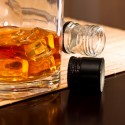Alaska alcohol: Bootleg bounty?
At the Barrow Distribution Centre business is brisk, and so it should be as the only place for 200 miles (320 km) where you can get alcohol.
Locals trot eagerly up the icy front steps, before emerging to struggle back down laden with cases of beer, bottles of spirits and boxes of red wine.
There is a party spirit among the steady stream of customers.
One woman is obviously pleased with her choice.
“I’ve got two cases of this great beer that I found, and a couple of bottles of tequila. I got just what I wanted,” she says.
The drink is loaded in their trucks then driven away through the snow to their homes.
Wet, dry, damp
The Barrow Distribution Centre is a small blue-painted wooden shack which stands on stilts right next to the town’s airport, a symbol of Barrow’s status as a so-called “damp” town, where alcohol is neither freely available nor banned outright.
Barrow’s supermarket shelves are stocked with dozens of soft drinks and juice, but alcohol is nowhere to be seen.
There are no bars in Barrow, not even in the many tourist hotels. Signs displayed in hotel lobbies warn they are Strictly No Alcohol. Guests are warned of fines up to $300 (£171) and police eviction for anyone caught breaking the rules.
There is a history of alcohol abuse among native people in Alaska, so under the State’s system of local referendums many communities choose to restrict consumption.
Barrow’s Police Captain Leon Boyea has to deal with more alcohol-related crime than anything else.
“Alcohol is the drug of choice on the North Slope”, he says.
He explains how excessive drinking has put Alaska near the top of the US table for crimes such as domestic violence and sexual assault.
Barrow has a large native population of Inupiat Eskimos. It is neither “wet” like Anchorage, where alcohol is freely sold, nor dry like the Inupiat villages of Kaktovik, Point Hope and Wainwright where even the possession of alcohol is illegal.
Instead, drink is available only to permit-holding residents who must order it from Fairbanks, 500 miles south, before paying to have it flown into Barrow. The permits cost $50 each year, and there is an administration charge on top.
Local laws
Most of the customers at the Distribution Centre seemed to think the system works.
“I think it’s right because that’s what the local people have decided,” said a woman carrying a case of American beer.
“That’s why Alaska has local option laws, so each community gets to decide. If you go to Nome you can’t drink, but people here decided that rather than having no access there would be some, and I think that works.”
But another said he was frustrated at the cost of the process.
“I am from the Philippines and I think Barrow should have a liquor store here. We pay $50 for a permit then we go to the police department, then to the city. Every year it’s $50.”
But the restrictions do not stop there, as there are strict quotas for how much each person can receive each month.
Strict but generous: each individual is allowed 4.5 litres (6 bottles) of spirits, 20 litres (26 bottles) of wine and 5 cases of beer.
Order all that and consume it in one month, and you have a serious drinking problem, according to Capt Boyea.
Don’t drink it all and sell it on illegally instead, and the problem becomes his.
“The biggest problem we have here is the sale of alcohol illegally, bootleg alcohol,” he says,
“You get people who have a full order, keep some for themselves, and then sell the rest. It’s actually a very lucrative trade. It makes sense to buy a product like whisky for $11 and sell it for $100 and that’s what you can do. You can sell it in a dry village for $150.”
Domestic violence
Selling alcohol in Barrow is a felony, a criminal offence that carries a penalty of up to five years in jail.
And one customer at the Distribution Centre, who asked not to be named, laughed off the idea of widespread bootlegging.
“Bootlegging? It’s against the law so nobody does it,” he insisted.
When asked if he’s certain no-one else is selling on their quota he laughs again.
“No, nope we don’t sell, we don’t bootleg around here, and we drink it all. All in one night. I joke.”
But things may be changing for the better.
As deputy director of behavioural health for North Slope Borough Council, Gail Reed is responsible for dealing with alcohol and drug addiction.
She accepts there are major problems in the community, but has recently become more optimistic.
“I see a maturing of the community where there’s less ambivalence about the harm and damage of drugs and alcohol,” she says.
“There’s a realisation that this is where we are, but this is not where we want to be.
“There’s now honest conversation about alcohol abuse and all that goes along with that, the domestic violence, chaotic families, putting children at risk. I continue to be inspired by a vision of a healthy community.”
But the police fear the opposite is the case, that drinking is on the rise and the reported cases of alcohol-related crimes such as domestic violence and bootlegging point to a serious problem.
_____________
source: BBC News


